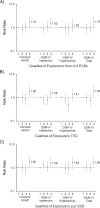Prenatal organochlorine exposure and behaviors associated with attention deficit hyperactivity disorder in school-aged children
- PMID: 20106937
- PMCID: PMC2842227
- DOI: 10.1093/aje/kwp427
Prenatal organochlorine exposure and behaviors associated with attention deficit hyperactivity disorder in school-aged children
Abstract
Organochlorines are environmentally persistent contaminants that readily cross the placenta, posing a potential risk to the developing fetus. Evidence for neurodevelopmental effects at low levels of these compounds is growing, though few studies have focused on behavioral outcomes. The authors investigated the association between prenatal polychlorinated biphenyl (PCB) and p,p'-dichlorodiphenyl dichloroethylene (p,p'-DDE) levels and behaviors associated with attention deficit hyperactivity disorder (ADHD), measured with the Conners' Rating Scale for Teachers (CRS-T), in a cohort of 607 children aged 7-11 years (median age, 8.2 years) born in 1993-1998 to mothers residing near a PCB-contaminated harbor in New Bedford, Massachusetts. The median umbilical cord serum level of the sum of 4 prevalent PCB congeners (118, 138, 153, and 180) was 0.19 ng/g serum (range, 0.01-4.41 ng/g serum). The authors found higher risk for ADHD-like behaviors assessed with the CRS-T at higher levels of PCBs and p,p'-DDE. For example, the authors found higher risk of atypical behavior on the Conners' ADHD Index for the highest quartile of the sum of 4 PCB congeners versus the lowest quartile (risk ratio = 1.76, 95% confidence interval: 1.06, 2.92) and a similar relation for p,p'-DDE. These results support an association between low-level prenatal organochlorine exposure and ADHD-like behaviors in childhood.
Figures

Similar articles
-
Measured Prenatal and Estimated Postnatal Levels of Polychlorinated Biphenyls (PCBs) and ADHD-Related Behaviors in 8-Year-Old Children.Environ Health Perspect. 2015 Sep;123(9):888-94. doi: 10.1289/ehp.1408084. Epub 2015 Mar 13. Environ Health Perspect. 2015. PMID: 25769180 Free PMC article.
-
Neuropsychological measures of attention and impulse control among 8-year-old children exposed prenatally to organochlorines.Environ Health Perspect. 2012 Jun;120(6):904-9. doi: 10.1289/ehp.1104372. Epub 2012 Feb 22. Environ Health Perspect. 2012. PMID: 22357172 Free PMC article.
-
Prenatal organochlorine exposure and measures of behavior in infancy using the Neonatal Behavioral Assessment Scale (NBAS).Environ Health Perspect. 2008 May;116(5):666-73. doi: 10.1289/ehp.10553. Environ Health Perspect. 2008. PMID: 18470320 Free PMC article.
-
Prenatal organochlorine and methylmercury exposure and memory and learning in school-age children in communities near the New Bedford Harbor Superfund site, Massachusetts.Environ Health Perspect. 2014 Nov;122(11):1253-9. doi: 10.1289/ehp.1307804. Epub 2014 Aug 6. Environ Health Perspect. 2014. PMID: 25062363 Free PMC article.
-
Lead and PCBs as risk factors for attention deficit/hyperactivity disorder.Environ Health Perspect. 2010 Dec;118(12):1654-67. doi: 10.1289/ehp.0901852. Epub 2010 Sep 9. Environ Health Perspect. 2010. PMID: 20829149 Free PMC article. Review.
Cited by
-
Measured Prenatal and Estimated Postnatal Levels of Polychlorinated Biphenyls (PCBs) and ADHD-Related Behaviors in 8-Year-Old Children.Environ Health Perspect. 2015 Sep;123(9):888-94. doi: 10.1289/ehp.1408084. Epub 2015 Mar 13. Environ Health Perspect. 2015. PMID: 25769180 Free PMC article.
-
Pre- and postnatal risk factors for ADHD in a nonclinical pediatric population.J Atten Disord. 2013 Jan;17(1):47-57. doi: 10.1177/1087054711427563. Epub 2012 Jan 31. J Atten Disord. 2013. PMID: 22298092 Free PMC article.
-
Developmental coexposure to polychlorinated biphenyls and polybrominated diphenyl ethers has additive effects on circulating thyroxine levels in rats.Toxicol Sci. 2012 May;127(1):76-83. doi: 10.1093/toxsci/kfs089. Epub 2012 Feb 17. Toxicol Sci. 2012. PMID: 22345314 Free PMC article.
-
Prenatal Exposure to Chemical Mixtures and Inhibition among Adolescents.Toxics. 2021 Nov 16;9(11):311. doi: 10.3390/toxics9110311. Toxics. 2021. PMID: 34822702 Free PMC article.
-
Neuropsychological measures of attention and impulse control among 8-year-old children exposed prenatally to organochlorines.Environ Health Perspect. 2012 Jun;120(6):904-9. doi: 10.1289/ehp.1104372. Epub 2012 Feb 22. Environ Health Perspect. 2012. PMID: 22357172 Free PMC article.
References
-
- Pelham WE, Foster EM, Robb JA. The economic impact of attention-deficit/hyperactivity disorder in children and adolescents. J Pediatr Psychol. 2007;32(6):711–727. - PubMed
-
- Grandjean P, Weihe P, Burse VW, et al. Neurobehavioral deficits associated with PCB in 7-year-old children prenatally exposed to seafood neurotoxicants. Neurotoxicol Teratol. 2001;23(4):305–317. - PubMed
-
- Jacobson JL, Jacobson SW. Intellectual impairment in children exposed to polychlorinated biphenyls in utero. N Engl J Med. 1996;335(11):783–789. - PubMed

